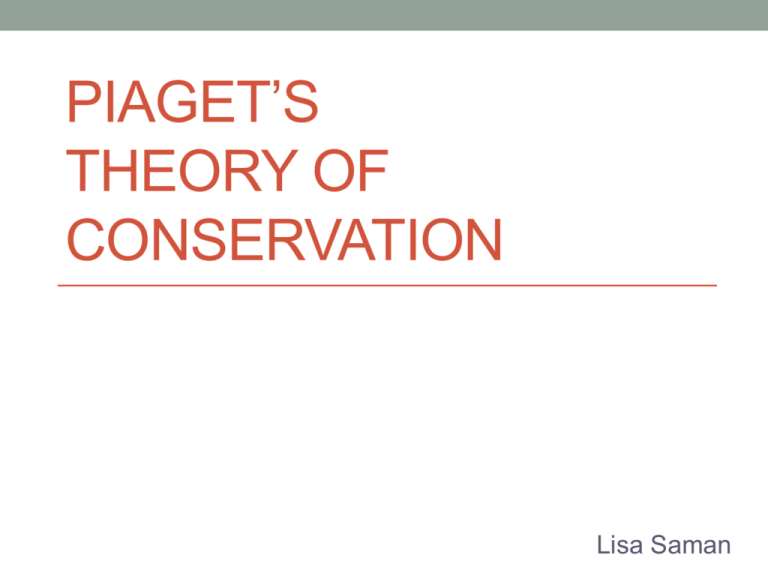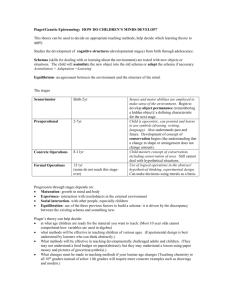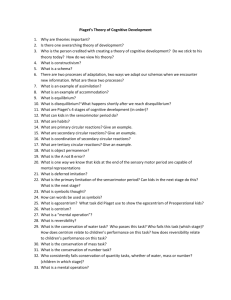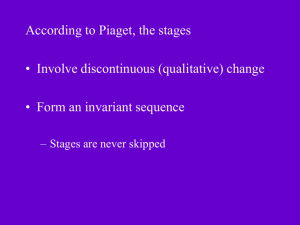
PIAGET’S
THEORY OF
CONSERVATION
Lisa Saman
Jean William Fritz Piaget (1896-1980)
• Born in Neuchâtel,
Switzerland on 9 August
1896
• Died 16 September 1980
• Began to study children in
1920
• Studied behaviors of his own
children
• Was interested in the
“wrong” answers
• At the age of ten, Piaget already
showed promise to becoming a
great scientist when he
published an observation journal
about sparrows
• His work has influenced many
other theorists. any other
research relating to cognitive
development can be traced back
to Piaget’s cognitive
development theory
• His stages were not genetically
determined. instead, his stages
“represent increasingly
comprehensive ways of
thinking” (114-115)
• Crain, W. (2005). Piaget's Cognitive-
Development Theory (pp. 112-150).
In Theories of development: Concepts and
applications (5th ed.). Upper Saddle River,
New Jersey: Pearson/Prentice Hall.
Piaget’s Stages of Cognitive Development
• Stage 1- Sensorimotor
• babies organize their physical action schemes, such as sucking,
grasping, and hitting, for dealing with the immediate world
• Stage 2- Pre-Operational
• children learn to think – to use symbols and internal images – but
their thinking is unsystematic and illogical
• Stage 3- Concrete Operational
• children develop the capacity to think systematically, but only when
they can refer to concrete objects and activities
• Stage 4- Formal Operational
• young people develop the capacity to think systematically on a
purely abstract and hypothetical plane
Conservation
• “The understanding that something stays the same in
quantity even though its appearance changes”
• Transition stage between Pre-Operational and Concrete
Operational Stages
• Seven types of conservation:
• Number (age seven or eight), length (age eight), liquid (age of
seven or eight), mass (age seven to eight), weight (age nine or
ten), area (age ten or eleven), and volume (age eleven or twelve)
McLeod, S. A. (2010). Concrete Operational Stage. Retrieved from www.simplypsychology.org/concreteoperational.html
Difference between
Pre-Operational
• Reasoning for answer
• Centration (one dimensional)
• “The child grasps that the two
corresponding sets are equal
only so long as the
containers are equal. When
one set is put into a container
of a different shape, the two
sets are no longer considered
as equal” (28)
Piaget, J. (1941). The child’s conception of
number (C. Gattegno & F. M. Hodgson, trans.).
London: Routledge & Kegan Paul, 1961.
Concrete Operational
• Reasoning for answer
• Identity
• Compensation
• Inversion
• “the transformation, although
the child is perfectly well
aware of it, is not conceived
as a reversible movement
from one state to another,
changing the form but leaving
the quantity constant” (98)
Piaget, J., & Inhelder, B. (1966). The “Concrete”
Operations of Thought and Interpersonal
Relations (pp. 92-99). In H. Weaver
(Trans.), The psychology of the child.
• The Psychology of the Child- Piaget and Inhelder
• All conservations “that are at the pre-operatory level
[show] the reactions are centered on perceptual or
imagined configurations, while at the operatory levels the
reactions are based on identity or reversibility by inversion
or reciprocity” (p.99).
• Piaget, J., & Inhelder, B. (1966). The “Concrete” Operations of Thought and Interpersonal Relations (pp.
92-99). In H. Weaver (Trans.), The psychology of the child.
Hypothesis
• I predict that Donaldson and Rose & Blank are correct in
predicting that Piaget underestimated children and that
the reason for this underestimation is the use of his
wording in his experimentation.
• To test this, I will reexamine Donaldson and McGarrigle’s
methods as well as Rose and Blank’s methods.
• The results of Piaget’s original experimentation will be
compared to the results of the tests of Donaldson &
McGarrigle and Rose & Blank.
Piaget’s Experiment- Conservation of Number
• Two rows of coins were shown to the child and the
question “Which row has more- this one, this one, or are
they the same?” was asked.
• One of the rows was then spread out
• The same question was asked again.
Piaget’s Experiment- Conservation of Liquid
• Two glasses of water were filled so they had the same amount
of water in each glass and the question “Which glass has
more- this one, this one, or are they the same?” was asked.
• One of the glasses was poured into a thinner glass
• The same question was asked again.
Donaldson and McGarrigle
• Donaldson and McGarrigle demonstrate that when simple
modifications, in language alone, are made to the
experiment, children are able to conserve at ages below
those predicted by Piaget. Making the tasks make sense
to the child and using child-friendly language in order to
make the task more understandable to the child, makes
them more likely to be able to conserve according to
Donaldson’s experiments.
• “the situation is more complicated than Piaget had
supposed and that there are common sources of failure in
conservation tests which his theory does not envisage”
(206).
Donaldson, M. (1982). Conservation: What is the question? British Journal of Psychology, 73, 199-207.
Donaldson’s Experiment
• A ‘Naughty Teddy’ was introduced in order to make the
change in the rows of coins seem accidental
• McGarrigle and Donaldson created a test to make the
account of conservation seem accidental rather than an
experimenter purposefully changing something and then
asking a question. Making the change seem accidental, a
child is more likely to conserve. The hypothesis of the test
was that: “if a ‘naughty teddy bear’ disarranged the array
in order to ‘mess up the game’ children would produce
more conserving responses than in the standard test’
(203). 1
• The results were that 70% more children conserved using
this method (20). 2
1. Donaldson, M. (1982). Conservation: What is the question? British Journal of Psychology, 73, 199-207.
2. Kefaloukos, Mary-Anne, & Bobis, Janette. (2011). Understanding conservation: A Playful Process.
APMC, 16 (4). Retrieved from http://files.eric.ed.gov/fulltext/EJ961654.pdf
Rose and Blank
• Rose and Blank “argued that Piaget had made a
methodological error by imposing demand characteristicswhen an adult deliberately changes something and asks
the same question twice, children think that a different
answer is expected, even though they may well be able to
conserve” (143).
Hill, G. (2001). The cognitive developmental approach to psychology (pp. 138-144). In A Level psychology
through diagrams (2nd ed.). Oxford: Oxford University Press.
Rose and Blank’s Experiment
• Rather than asking a child whether the two rows of coin or
two glasses of water are the same before and after the
changes have been made, the question: “Which one has
more- this one, this one, or are they the same?” is only
asked once.
• It is asked after the changes have taken place.
Experimentation
• Holy Family of Nazareth Catholic School
• 1st graders
• Ages of the children varied from 6.2 to 7.3
• 11 children
• 2 got sick after the first experimentation so the final results only
have 9 children.
• Piaget’s test was done on Monday
• Donaldson’s test was done on Wednesday
• Rose and Blank’s test was done on Thursday
Results- Conservation of Number
• Can students conserve?
Student
Age
Piaget
Donaldson
Rose and Blank
1
7.3
Yes
Yes
Yes
2
6.6
Yes
Yes
Yes
3
6.2
No
No
No
4
6.2
No
No
No
5
6.11
No
No
No
6
6.3
No
No
No
7
7.1
No
Yes
No
8
6.11
Yes
Yes
Yes
9
6.6
No
No
No
Results- Conservation of Liquid
• Can students conserve?
Student
Age
Piaget
Donaldson
Rose and Blank
1
7.3
No
Yes
Yes
2
6.6
No
No
No
3
6.2
No
No
No
4
6.2
No
No
No
5
6.11
No
No
No
6
6.3
No
No
No
7
7.1
No
No
No
8
6.11
No
Yes
Yes
9
6.6
No
No
No
Results in conclusion
• Conservation of Number
• Using Donaldson’s method, only 1 child was able to conserve
compared to Piaget’s method, which amounts in a 11.1% change.
• Using Rose and Blank’s method, there were no changes compared
to Piaget’s method.
• Conservation of Liquid
• Using Donaldson’s method, only 2 children were able to conserve
compared to Piaget’s method, which amounts in a 22.2% change.
• Using Rose and Blank’s method, those same 2 children were able
to conserve amounting in a 22.2% change.
• The children who were able to conserve using either
Donaldson or Rose and Blank’s method were all 6.11 or
older.
Conclusion
Piaget was right!
• Children can only conserve at the age of about seven
years old.
• Though tests were done using other methods, the biggest
percent in change was 22.2%
Limitations and Problems
• The small amount of children
• Short amount of time for testing
• When doing the Rose and Blank experiment (3rd time
testing), about half of the students already told me the
rows or glasses were the same before asking any
questions.
• This is most likely because I did the Donaldson experiment with
them the day before and they remembered the experiment too
vividly.
• “You always do the same with us” – 1st grader
• Classroom setting which was a bit noisy at times and
sometimes brought up distractions with other children
looking on at what I was doing.
Nature vs Nurture
Rousseau
Piaget
Vygotsky
Locke
|_________________|______|______|________________|
Nature
Nurture
Bibliography
• Crain, W. (2005). Piaget's Cognitive-Development Theory (pp. 112-150).
•
•
•
•
•
•
•
•
In Theories of development: Concepts and applications (5th ed.). Upper Saddle
River, New Jersey: Pearson/Prentice Hall.
Donaldson, M. (1978). Children’s minds: What Is Said and What Is Meant (pp.5774).New York: W.W. Norton, 1979.
Donaldson, M. (1982). Conservation: What is the question? British Journal of
Psychology, 73, 199-207.
Hill, G. (2001). The cognitive developmental approach to psychology (pp. 138144). In A Level psychology through diagrams (2nd ed.). Oxford: Oxford
University Press.
Kefaloukos, Mary-Anne, & Bobis, Janette. (2011). Understanding conservation: A
Playful Process. APMC, 16 (4). Retrieved from
http://files.eric.ed.gov/fulltext/EJ961654.pdf
McLeod, S. A. (2010). Concrete Operational Stage. Retrieved from
www.simplypsychology.org/concrete-operational.html
Piaget, J., & Inhelder, B. (1966). The “Concrete” Operations of Thought and
Interpersonal Relations (pp. 92-99). In H. Weaver (Trans.), The psychology of the
child.
Piaget, J. (1941). The child’s conception of number (C. Gattegno & F. M.
Hodgson, trans.). London: Routledge & Kegan Paul, 1961.
Rose, S., & Blank, M. (1974). The Potency of Context in Children's Cognition: An
Illustration through Conservation. Child Development, 45, 499-502.








